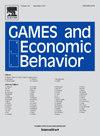最优树竞赛设计,赢者通吃
IF 1
3区 经济学
Q3 ECONOMICS
引用次数: 0
摘要
本文研究了具有树状结构的多阶段竞赛的努力最大化设计,重点研究了竞赛结构和奖品结构。给定该体系结构,我们表明整个预算应该分配给单个匹配。如果体系结构是对称的,则此匹配必须是最终匹配。此外,当竞赛组织者能够共同设计建筑和奖品结构时,赢家通吃规则被证明是最优的。为了确定最优的竞赛结构,我们使用动态规划和归纳法为优化的总努力水平提供一个紧密的上界。我们的新方法扩展了Gradstein和Konrad(1999)的发现,提供了关于最佳结构如何取决于比赛噪声水平的新见解。本文章由计算机程序翻译,如有差异,请以英文原文为准。
Optimal tree contest design and winner-take-all
This paper investigates the effort-maximizing design of multi-stage contests with tree-like architectures, focusing on both contest architecture and prize structure. Given the architecture, we show that the whole budget should be assigned to a single match. This match must be the final if the architecture is symmetric. Moreover, the winner-take-all rule proves to be optimal if the contest organizer can jointly design the architecture and prize structure. To determine the optimal contest architecture, we use dynamic programming and induction to provide a tight upper bound for the optimized total effort level. Our new approach extends the findings of Gradstein and Konrad (1999), offering new insights into how the optimal architecture hinges on the noise level of matches.
求助全文
通过发布文献求助,成功后即可免费获取论文全文。
去求助
来源期刊

Games and Economic Behavior
ECONOMICS-
CiteScore
1.90
自引率
9.10%
发文量
148
期刊介绍:
Games and Economic Behavior facilitates cross-fertilization between theories and applications of game theoretic reasoning. It consistently attracts the best quality and most creative papers in interdisciplinary studies within the social, biological, and mathematical sciences. Most readers recognize it as the leading journal in game theory. Research Areas Include: • Game theory • Economics • Political science • Biology • Computer science • Mathematics • Psychology
 求助内容:
求助内容: 应助结果提醒方式:
应助结果提醒方式:


